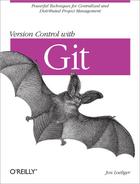Git manages change. Given that intent, Git shares much with other version control systems. Many tenets—the notion of a commit, the change log, the repository—are the same, and workflow is conceptually similar among the corpus of tools. However, Git offers many novelties, too. The notions and practices of other version control systems may work differently in Git or may not apply at all. Yet, no matter what your experience, this book explains how Git works and teaches mastery.
Let’s get started.
Git is simple to use. Just type git. Without any arguments, Git lists its options and the most common subcommands:
$ git
git [--version] [--exec-path[=GIT_EXEC_PATH]]
[-p|--paginate|--no-pager] [--bare] [--git-dir=GIT_DIR]
[--work-tree=GIT_WORK_TREE] [--help] COMMAND [ARGS]
The most commonly used git commands are:
add Add file contents to the index
bisect Find the change that introduced a bug by binary search
branch List, create, or delete branches
checkout Checkout and switch to a branch
clone Clone a repository into a new directory
commit Record changes to the repository
diff Show changes between commits, the commit and working trees, etc.
fetch Download objects and refs from another repository
grep Print lines matching a pattern
init Create an empty git repository or reinitialize an existing one
log Show commit logs
merge Join two or more development histories
mv Move or rename a file, a directory, or a symlink
pull Fetch from and merge with another repository or a local branch
push Update remote refs along with associated objects
rebase Forward-port local commits to the updated upstream head
reset Reset current HEAD to the specified state
rm Remove files from the working tree and from the index
show Show various types of objects
status Show the working tree status
tag Create, list, delete, or verify a tag object signed with GPGFor a complete (and somewhat daunting) list of git subcommands, type git help --all.
As you can see from the usage hint, a small handful of options apply to git. Most options, shown as [ARGS] in the hint, apply to specific subcommands.
For example, the option --version affects the git command and produces a version number:
$ git --version
git version 1.6.0In contrast, --amend is an example of an option specific to the git subcommand commit:
$ git commit --amendSome invocations require both forms of options (here, the extra spaces in the command line merely serve to visually separate the subcommand from the base command and are not required):
$ git --git-dir=project.git repack -dFor convenience, documentation for each git
subcommand is available using either git help
or subcommandgit
.subcommand --help
Historically, Git was provided as a suite of many simple, distinct, standalone commands developed according to the “Unix toolkit” philosophy: build small, interoperable tools. Each command sported a hyphenated name, such as git-commit and git-log. However, the current trend among developers is to use the single git executable and affix a subcommand. That said, both forms, git commit and git-commit, are identical.
Note
You can visit http://www.kernel.org/pub/software/scm/git/docs/ to read the complete Git documentation online.
Git commands understand both “short” and “long” options. For example, the git commit command treats the following examples as equivalents:
$git commit -m "Fixed a typo."$git commit --message="Fixed a typo."
The short form, -m, uses a single hyphen,
whereas the long form, --message, uses two. (This is
consistent with the GNU long options extension.) Some options exist only
in one form.
Finally, you can separate options from a list of arguments via the “bare double dash” convention. For instance, use the double dash to contrast the control portion of the command line from a list of operands, such as filenames:
$ git diff -w master origin -- tools/MakefileYou may need to use the double dash to separate and explicitly identify filenames if they might otherwise be mistaken for another part of the command. For example, if you happened to have both a file and a tag named main.c, you would get different behavior:
# Checkout the tag named "main.c" $git checkout main.c# Checkout the file named "main.c" $git checkout -- main.c
